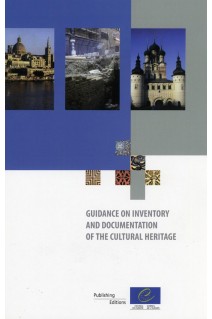



Improved heritage management and the inclusion of heritage in planning and sustainable development processes necessitate inventory and documentation. More than mere scientific tools recommended in international agreements, inventory and documentation play a strategic role. The complexity of the heritage items that now have to be inventoried and their interaction with our everyday living environment require the clear definition and harmonisation of practices at the European level.Through its work in the 1960s, the Council of Europe helped to lay the methodological bases for inventorying architectural, archaeological and movable heritage. The efforts to systematise the process came in answer to the broadening meaning of heritage, and today new considerations lead us to address such notions as heritage groups.The guidelines proposed in this book reflect the work done so far and provide a basis for future research. It is part of a series produced under the Technical Co-operation and Assistance Programme to present the experience derived from the projects implemented by the Council of Europe.
Foreword
Introduction
Summary of the main chapters
1. The documentation of the built heritage
2. The role of the inventory
2.1 Inventory and heritage
2.2 Specificity and diversity
2.3 The evolution of the environment: the priority of the heritage
3. Uses and types of inventory
3.1 Uses of the inventory
3.2 Identification and analysis
3.3 Conservation: identifying needs
3.4 Planning
3.5 Education, the raising of awareness and the promotion of understanding
3.6 Types of inventory
3.7 Selective inventory
3.8 Exhaustive inventory
3.9 Topographical inventory
3.10 Thematic inventory
4. The inventory as a means of protective legislation
4.1 Inventory and protection
4.2 Extent of information required
4.3 Public support for heritage protection
4.4 From protective legislation to building management
5. The edifice and the ensemble
5.1 The unit of study
5.2 The analysis of the ensemble
5.3 Classifying the ensemble
5.4 Defining the ensemble
5.5 Types of ensemble
6. The implementation of new structures for inventorisation and heritage management
6.1 Managing the process
6.2 Introducing standards
6.3 Managing change
7. The inventory as a continuing process
7.1 Coherence of the inventory
7.2 Updating the inventory
7.3 Documentation unity
7.4 Clarity of documentation
8. Responsibility for information
8.1 Access to information
8.2 Ownership of information
9. Information and data standards
9.1 Information standards
9.2 Data standards
9.3 Geographical information systems
9.4 National data contents standards and terminology
9.5 Terminology
9.6 Criteria for data entry
9.7 Commissioning new technologies
9.8 Standards for documentation
10. Training
10.1 Training courses
10.2 Expanding expectations
11. Introduction to standards
11.1 Core data index to historic buildings and monuments of the architectural heritage
11.2 Core data standard for archaeological sites and monuments
11.3 Object ID
12. The standards
12.1 Core data index to historic buildings and monuments of the architectural heritage
12.2 International core data standard for archaeological sites and monuments
12.3 Object ID
12.4 Object ID -checklist
13. Examples
13.1 Core data index to historic buildings and monuments of the architectural heritage
13.2 Core data index to ensembles of buildings, monuments and sites, based on the core data index to historic buildings and monuments
13.3 Core data standard for archaeological sites and monuments
13.4 Object ID
Appendices
Appendix I: Recommendation R (95) 3 of the Committee of Ministers of the Council of Europe to member states on co-ordinating documentation methods and systems related to historical buildings and monuments of the architectural heritage (adopted by the committee of ministers on 11 January 1995 at the 525th meeting of the ministers' deputies)
Appendix II: Information interchange, metadata, and geographical information system standards
Appendix III: Revised core data index to historic buildings and monuments of the architectural heritage
Selected bibliography
Download an extract (1000)

Improved heritage management and the inclusion of heritage in planning and sustainable development processes necessitate inventory and documentation. More than mere scientific tools recommended in international agreements, inventory and documentation play a strategic role. The complexity of the heritage items that now have to be inventoried and their interaction with our everyday living environment require the clear definition and harmonisation of practices at the European level.Through its work in the 1960s, the Council of Europe helped to lay the methodological bases for inventorying architectural, archaeological and movable heritage. The efforts to systematise the process came in answer to the broadening meaning of heritage, and today new considerations lead us to address such notions as heritage groups.The guidelines proposed in this book reflect the work done so far and provide a basis for future research. It is part of a series produced under the Technical Co-operation and Assistance Programme to present the experience derived from the projects implemented by the Council of Europe.
Please note that in accordance with our terms & conditions, PDF/epubs may only be purchased by private individuals.
